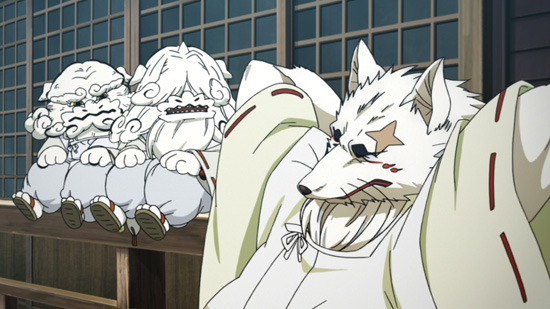
Religion can be a divisive subject, to say the least. The myriad denominations around the world and throughout human history differ in a great number of ways. Some adhere to a singular god, others an entire pantheon. Some believers take comfort in the concept of an afterlife removed from the challenges of the mortal realm, while others expect to be reincarnated for another go at it. But one thing is common among all faiths, and it’s right there in said label—faith, the act of trusting in that which cannot be proven via any scientific methods known to man.
But what if the divine was tangible? What if you could feel the weight of it in your hands, or even carry on a conversation with supernatural beings? It’s this curious notion that lands us square in the lap of Gingitsune: Messenger Fox of the Gods, studio Diomedéa’s anime adaptation of Sayori Ochiai’s slice-of -ife manga of the same name, in which seeing truly is believing.

Makoto Saeki is an ordinary girl with an extraordinary gift. You see, Makoto descends from a line of Shinto shrine keepers that have been tending to the small and humble Saeki Inari Shrine, one of many shrines scattered across Japan built in honor of Inari, the god of foxes—this one specifically dedicated to the deity Uka-no-Mitama, god of agriculture, who is associated with Inari. With that lineage comes a very special ability. A true successor to a Shinto shrine in the world of Gingitsune is bestowed with The Sight, which allows one to see heralds, messengers of the gods, and when Makoto’s mother, the previous successor, passes away, Makoto inherits this remarkable skill at the tender age of four.
And thus we, and she, are introduced to Gintaro, our titular “silver fox,” the meaning of “Gingitsune.” But for a being that acts as a go-between for the humans and gods, Gintaro isn’t exactly as heavenly as you may imagine. He’s lazy, preferring to wile his days away napping, and puts on an air of surliness even though he’s a softie deep down, helping to raise Makoto every bit as much as her widower father, Tatsuo. As for his power to predict the future and divine other information, that’s just too much of a pain, ain’t it? What’s a fox gotta do to get some peace and quiet?
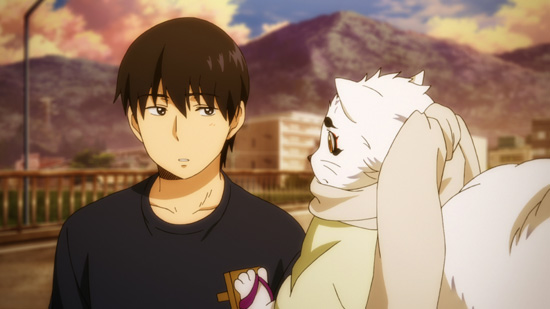
Perhaps Gin, as Makoto calls him, should request an offering of earplugs, since happenings only get more boisterous, as new friends are welcomed into their lives. When Makoto isn’t performing duties as a part-time shrine maiden and chewing out Gintaro for being a grouch, she attends high school like any other teenager. It’s there she meets classmates Yumi Ikegami, an animal lover who manages to be popular despite her headstrong nature, and Hiwako Funabashi, the haughty daughter of an affluent politician.
Even though Makoto is about as sweet as they come, she doesn’t quite get off on the right foot with these girls, and tenser interactions yet are in her future when she meets Satoru Kamio, another true successor, and his Inari shrine’s feisty little brat of a herald, Haru. Like Makoto, Satoru gained The Sight at an unusually young age, but life circumstances have caused Satoru to build walls around himself, retreating from contact with other humans.
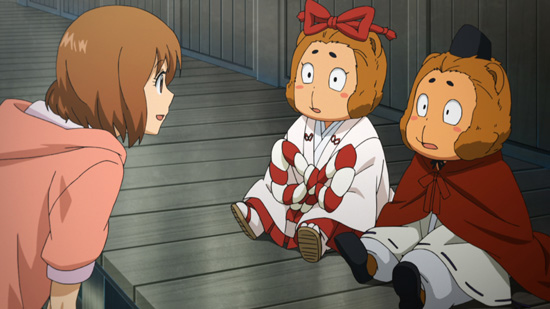
Minor characters come and go, such as Hiwako’s driver and Yumi’s boyfriend, not to mention a whole slew of other heralds, but here we have our main cast. And honestly, not a great deal happens to them. The drama occurring over the 12-episode run of Gingitsune rarely gets any severer than a lost cat or a bad tummy ache, and there are no placard-worthy accomplishments made by this crew, either. However, each character does grow in his or her own subtle way, and those small strides in life are oftentimes the most valuable, as they carry one forward step by step.
Much can be learned from the slow-and-steady approach to life seen in Gingitsune, and more yet can be garnered from its seemingly deliberate teachings. Gingitsune gives off an educational vibe, as if to speak to the youth of Japan who may not be well-versed in the practices of Shinto shrines. The average Western viewer likely knows even less about the Shinto faith, so those looking to expand their minds need only watch and listen. Although, like its plot, there are gaps that go unfilled, with some figures and rituals name dropped without explanation.
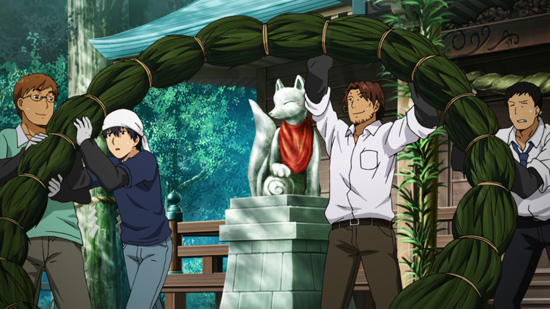
Gingitsune is literally a slice of life, in that we are never treated to the whole picture. Intriguing plot points are raised but dropped, most notably the matter of Gintaro’s absent partner. We are made privy to bits and pieces of the past that aren’t explored to a satisfying degree. The viewer is left hanging on these loose ends, and while a second season could rectify this, no such announcement has been made thus far. Those who want to cling to hope can take solace in the fact that the Gingitsune manga is still ongoing and, in time, could build up enough material for future animation.
One can only hope that if Gingitsune is continued that it will live up to the animation already available, which is quite easy on the eyes. Human character designs are relatively simplistic and sport soft, pudgy faces, meanwhile the more heavily stylized heralds come in all shapes and sizes, with some resembling actual animals and others anthropomorphized. But what appears to have been graced with the most concerted effort is the background art. From the idyllic Japanese countryside to the detailed shrine architecture, Gingitsune portrays a city that cherishes the past as much as it embraces the future. A delicate, gentle soundtrack suits the visuals and plot nicely, as it invokes memories of days gone by and moments you wish could last forever.
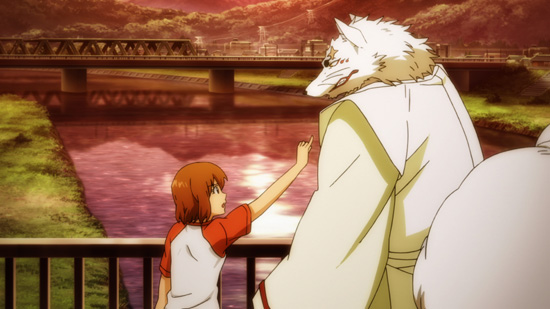
As a heartfelt, family-friendly series that mixes the mystical and the mundane, tradition and modern life, Studio Ghibli fans would likely find much to love in Gingitsune, even if it, as to be expected, isn’t nearly on the same level of beauty, charm, and poignancy. But to make such a comparison at all says much about Gingitsune. Those seeking warm and fuzzy feelings to survive the cold winter months ahead could do worse than to snuggle up with a big, fluffy, albeit grumpy, silver fox.



![SSSS.Dynazenon [Anime Review] SSSS.Dynazenon [Anime Review]](https://otakuusamagazine.com/wp-content/uploads/2021/08/16-9-SSSS.Dynazenon_Key_Visual_3.5-480x360.jpg)
![Back Arrow [Anime Review] Back Arrow [Anime Review]](https://otakuusamagazine.com/wp-content/uploads/2021/07/ba15-02686-480x360.jpg)
![Dawn of the Witch [Manga Review] Dawn of the Witch [Manga Review]](https://otakuusamagazine.com/wp-content/uploads/2021/07/16-9-DawnoftheWitch-cvr_02-480x360.jpg)
![Nina The Starry Bride [Manga Review] Nina The Starry Bride [Manga Review]](https://otakuusamagazine.com/wp-content/uploads/2021/07/nina-the-starry-bride-v1-16-9-480x360.jpg)
